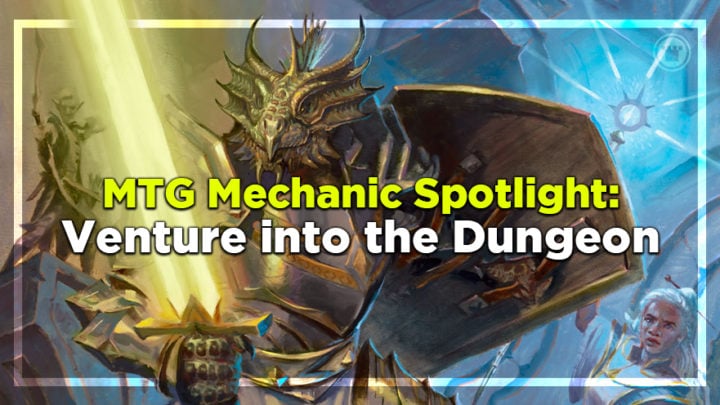Normally, this is where I’d be crowing over WotC confirming my predictions article – but I don’t think anybody’s impressed that I guessed the “Dungeons & Dragons set” would have dungeons in it! People searching for information about Adventures in the Forgotten Realms are going to expect two things, and since Dragons show up in every Magic product, the dungeons were the clear choice to set the tone of this set.
But what wasn’t so easy to predict was the shape these dungeons would take. Famous D&D dungeons contain a multitude of traps and monsters to test adventurers, but how to show all that through one card? And how will the dungeon interact with its controller? Are we the adventurers here, or the Dungeon Master?
DUNGEON AHEAD: ENTER AT OWN RISK
When I first took a stab at how dungeons could work, I predicted they might be legendary lands — it’s the means we already have to represent a physical location in Magic. Lands also make good marquee cards for a set, as they are more likely to impact older formats than an expensive spell. But as discussed in that piece, representing dungeons as lands would force WotC to restrict their power; just look at what Urza’s Saga has done over the past month.
Luckily, my other guess for how to implement dungeons turned out to be right on the money:
If WotC’s goal was for this mechanic to define the AFR play experience, it’s actually a massive upgrade to having dungeons appear as cards you slot into your deck. Because players will always technically have access to dungeons, designers have massive freedom in how specific cards utilize the mechanic. In this case, many of them will generate a trigger for you to “venture into the dungeon.” As predicted, this is where you choose a dungeon to put into play (sort of) from outside the game. But instead of taking up a sideboard slot like companions, you simply create one of three predetermined dungeons in your command zone when you first resolve a venture trigger.
DUNGEONEERING: FROM START TO FINISH
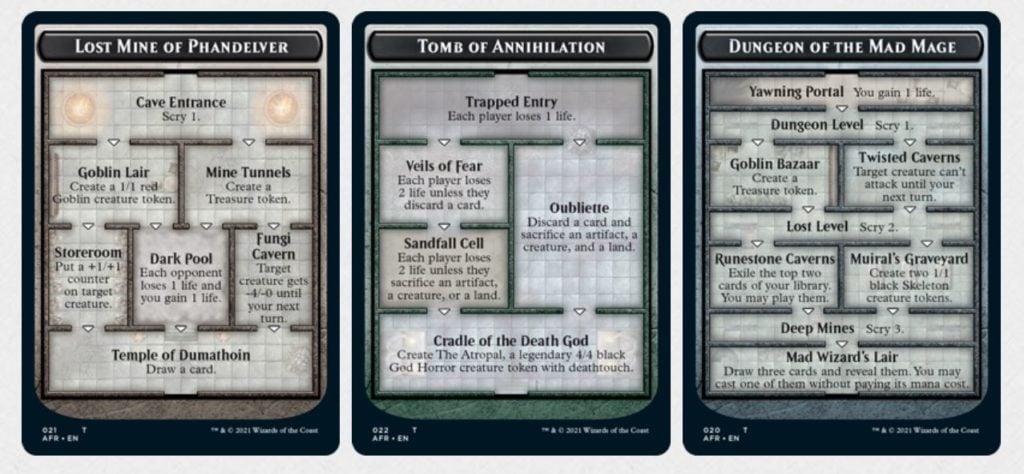
You’ll always have the same three dungeons to choose from when venturing in, so everyone should find themselves familiar with their play patterns quite quickly. The dungeon cards themselves are laid out sort of like Sagas: a sequence of triggered abilities, corresponding to dungeon floors, which you progress through from top to bottom. However, the dungeons will sometimes have split paths, which give you a bit of flexibility, even within this fixed progression. You also don’t get to trigger these dungeons automatically each main phase, even after you’ve put one into your command zone with that first venture. Instead, later “venture into the dungeon” triggers will each advance you to the next floor down as they resolve.
When you reach the final floor and trigger its ability (regardless of what happens to that ability), you’ve completed the dungeon! Not only are those final effects quite impactful, but you’ll get an invisible, permanent status (much like the City’s Blessing from Rivals of Ixalan) which powers up many AFR cards for the rest of the game! You can keep on venturing, though — you either go back to that same dungeon and start again, or you can choose one of the other two dungeons to take on next.
There’s no special benefit to completing all three dungeons in one game, and you can’t venture into a new dungeon until you complete the one you’re already exploring. But each of the three famous dungeons will have their appeal in specific situations, and I’m very impressed by the variety and power concealed within!
THE SELLSWORD’S TRAVEL GUIDE
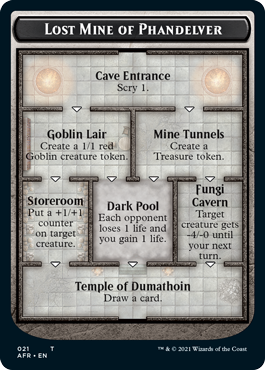
The Lost Mine of Phandelver is your “default” dungeon option if you’re not sure what else to do with your spare venture triggers. All of its abilities are good in generic ways, providing bonus resources and some optional board control. It’s also not too deep in floors, allowing you to gain the “dungeon completed” status with just four ventures! Expect to be using this one a lot in Draft, especially if your deck isn’t especially heavy on either venture triggers or “completed” payoffs.
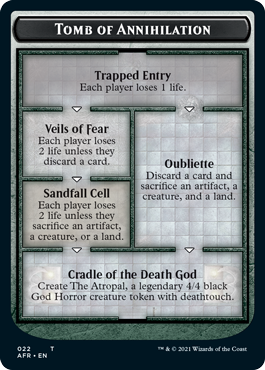
Venturing into the Tomb of Annihilation — the legendary lair of the lich Acererak, which has claimed hundreds of thousands of character sheets since the 1970’s — is a far more aggressive commitment. Fittingly for a cruel and lethal locale, venturing through here quickly drains resources from everyone at the table to help birth The Atropal, the infant form of a new death god. There is also an option to provide all of The Atropal’s nourishment yourself, which allows you to complete this dungeon in just three venture triggers. Remember, we’ve already seen creatures and planeswalkers previewed which can generate free venture triggers every turn!
This will be the dungeon of choice for aggro decks, particularly those whose creatures benefit from completing a dungeon. Not only is the 4/4 token a far more significant benefit in the early game, but being able to threaten having it a turn early with the shorter dungeon path is a big deal — even if the price is quite high.
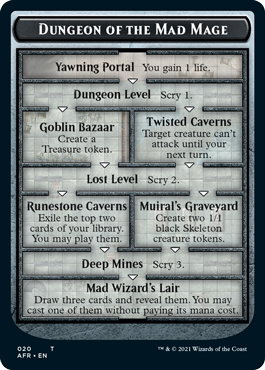
Finally, the Dungeon of the Mad Mage is a payoff for slower decks which care more about generating incremental value from venture triggers than getting the “completed” status ASAP. Like the Lost Mine, each floor offers a solid chunk of resources or card selection, scaling up in power as you go. The final floor takes a massive seven triggers to reach — twice as many as the others — but the payoff is significant, in a way that scales far better than a 4/4 Atropal token.
“CAN I SEE IF THERE’S ANY TRAPS?”
It’s hard to fully estimate how a mechanic this unique will impact Magic ahead of time. We can at least confirm that it will work as intended in Commander! But I’m already volunteering a round of applause for WotC’s ingenuity and complete confidence in putting out such a wild and different kind of mechanic. The negative consequences of the F.I.R.E.-era design philosophy tend to get a lot of airplay, and we should at least acknowledge the experimentation and cool mechanics that bold design work has delivered us.
Venture is a set mechanic that works everywhere, but would love to work with itself wherever possible; I see it as comparable to energy in many ways. For instance: you always have the potential to use dungeons in any deck, including if you steal an opponent’s dungeon-venturing effect. In both cases, all your dungeoneering cards contribute incrementally toward an eventual payoff, making decks redundant and flexible.
The subtle distinction between optimizing cards with venture and dungeons you want to complete is really cool to see built into a mechanic so organically, and it’s my favorite aspect of this design overall. I’m sure that as AFR spoiler season evolves, we’ll continue to see dungeon-focused cards split into either the aggressive “rush-to-complete” or conservative “venture-for-value” lanes — and I’m just as sure that people will find ways to blend those both into one deck regardless. That’s just the kind of creativity that new cards and mechanics like this can inspire!

Tom’s fate was sealed in 7th grade when his friend lent him a pile of commons to play Magic. He quickly picked up Boros and Orzhov decks in Ravnica block and has remained a staunch white magician ever since. A fan of all Constructed formats, he enjoys studying the history of the tournament meta. He specializes in midrange decks, especially Death & Taxes and Martyr Proc. One day, he swears he will win an MCQ with Evershrike. Ask him how at @AWanderingBard, or watch him stream Magic at twitch.tv/TheWanderingBard.

